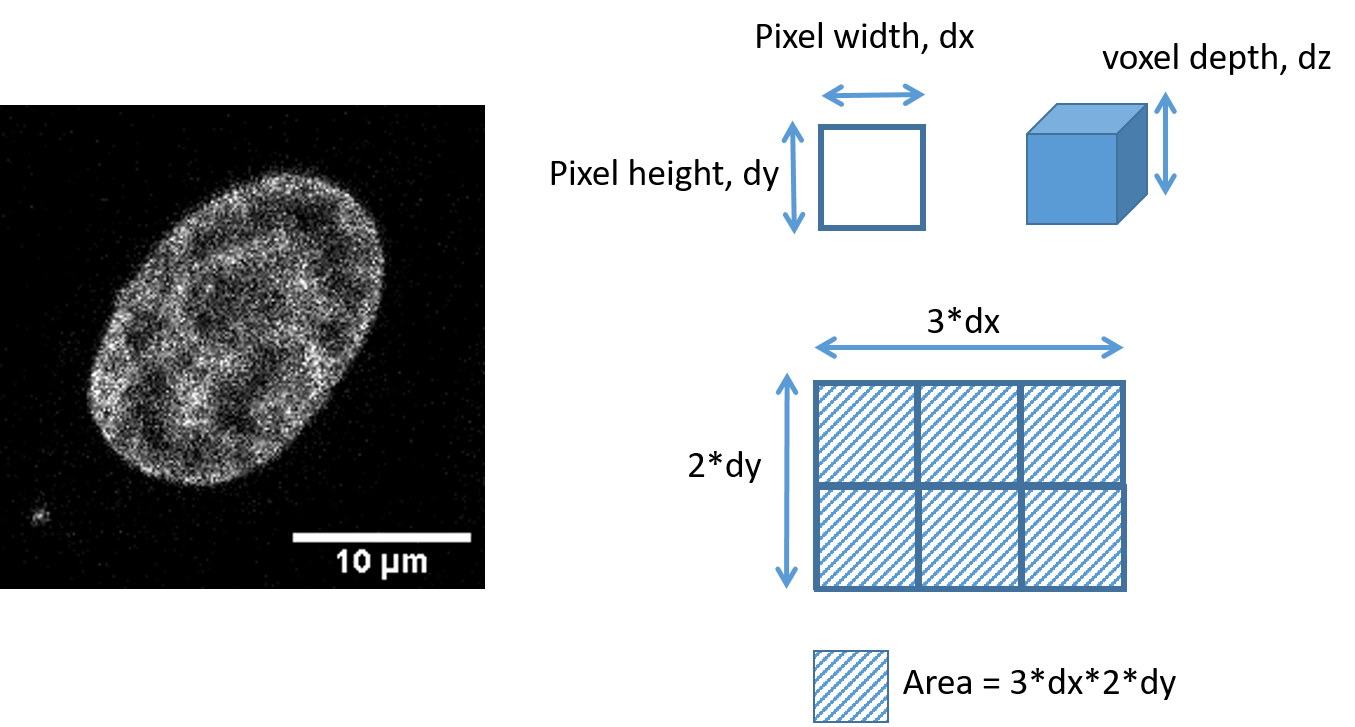Spatial calibration
Prerequisites
Before starting this lesson, you should be familiar with:
Learning Objectives
After completing this lesson, learners should be able to:
Understand that a pixel index is related to a physical coordinate.
Understand that a spatial calibration allows for physical size measurements.
Motivation
We would like to relate the image dimensions to a physical size. The relation between pixels and physical size is referred to as spatial calibration. Image calibration is dictated by acquisition and detection parameters of a microscope, such as magnification, camera detector size, sampling, etc, and is usually stored within the so-called image metadata. Before performing quantitative measurements, e.g. volume, area, …, you should make sure that the spatial calibration has been set appropriately.
Concept map
Example figure

Isotropy
One speaks of isotropic sampling if the pixels have the same extent in all dimensions (2D or 3D).
While microscopy images typically are isotropic in 2D they are typically anisotropic in 3D with coarser sampling in the z-direction.
It is very convenient for image analysis if pixels are isotropic, thus one sometimes resamples the image during image analysis such that they become isotropic.
Activity
- Open image: xyz_8bit__mitotic_plate_calibrated.tif
- Emphasize where to find spatial calibration image metadata and why it can be important.
- Explain how to edit spatial calibration and perform consistency checks.
- Show how to measure the Euclidian calibrated distances of pixels in 2D and 3D.
ImageJ GUI
Explore pixel sizes
- Open image: xyz_8bit__mitotic_plate_calibrated.tif
- Check the pixel sizes (calibration) of this image
- Where to see the calibration?
- Next to the pixel indices in the ImageJ menu bar
- Properties of the image [Image > Properties] or [Shift-Ctrl-P]
- How to check whether the calibration makes sense?
- Explore the typical size of objects in 3D.
- Orthogonal view [Image > Stacks > Orthogonal Views] or [Ctrl-Shift-H]
- An example of a wrong calibration: xyz_8bit__mitotic_plate_badZcalibrated.tif
- Appreciate that image calibration might be necessary, e.g.
- 2D distance measurement between two pixels
- One can use the Line tool
- 3D distance measurement between two voxels
- One cannot use the Line tool but needs to measure manually:
sqrt( (x0-x1)^2 + (y0*-y1*)^2 + (z0-z1)^2 )
- Note: It is critical to use the calibrated voxel positions and not the voxel indices in above formula!
- Appreciate that image calibration can be confusing, e.g.
- It is not consistently used in image filter parameter specification
Exercises
Show exercises for:ImageJ GUI
- Open xy_8bit__nucleus_calibrated.tif and note down the pixel width and pixel height.
- Open xyz_8bit__nucleus.tif and add the spatial calibration. The pixel width and pixel height is the same as previous image. Voxel-depth is 0.52 um.
- What is the length of the longest axis of the nucleus?
Solution
- [File > Open ] the image and then [Image > Properties …] or [Ctrl-Shift-P]. Pixel-height = pixel-width = 0.13 um.
- Open the 3D image and change the properties from the [Image > Properties …] gui and the unit.
- Maximal extension is ~ 19.2 um. Move to the middle of the nucleus (~ z-slice 3) and draw a line using the line-tool.
Assessment
Fill in the blanks
- Given a 2D image with
pixel height=pixel width=dxy=0.13 micrometer, what distance do the pixels at the (x,y) indices (10,10) and (9,21) have in micrometer units? - Given a 3D image with
dx=dy=0.13 micrometeranddz=1 micrometer, what is the calibrated (micrometer units) distance of two pixels at the indices(10,10,0)and(9,21,3)? - What is the calibrated (micrometer units) area covered by 10 pixels, given a spatial calibration of
dx=dy=0.13 micrometer? - What is the calibrated (micrometer units) volume covered by 10 voxels, given a spatial calibration of
dx=dy=0.13 micrometeranddz=1 micrometer?
Solution
sqrt( (x0*dxy-x1*dxy)^2 + (y0*dxy-y1*dxy)^2 )=sqrt( (x0-x1)^2 + (y0-y1)^2 ) * dxy=sqrt( (10-9)^2 + (10-21)^2 ) * 0.13=11.04536 * 0.13 micrometer = 1.435897 micrometer. The fact that one can separate out the isotropic calibrationdxyin the formula allows one to perform measurements in pixel units and convert the results to calibrated units later, by means of multiplication withdxy.sqrt( (x0*dx-x1*dx)^2 + (y0*dy-y1*dy)^2 + (z0*dz-z1*dz)^2 )=sqrt( (10*0.13-9*0.13)^2 + (10*0.13-21*0.13)^2 + (0*1.0-3*1.0)^2 ) micrometer=3.325928 micrometer. Unfortunately, in an anisotropic 3D image one cannot separate out a calibration factor from the formula, making life more difficult.10 * 0.13 micrometer * 0.13 micrometer=10 * 0.0169 micrometer square=0.169 micrometer square10 * 0.13 micrometer * 0.13 micrometer * 1.0 micrometer=10 * 0.0169 micrometer cube=0.169 micrometer cube. This shows that measuring volumes in 3D can be done first in voxel units, as the calibration factor can easily taken into account later (in contrast to the distance measurements). Thus, somewhat surprisingly, is in practice easier to measure volumes than distances in 3D.
Follow-up material
We recommend reading these modules next:
Learn more: